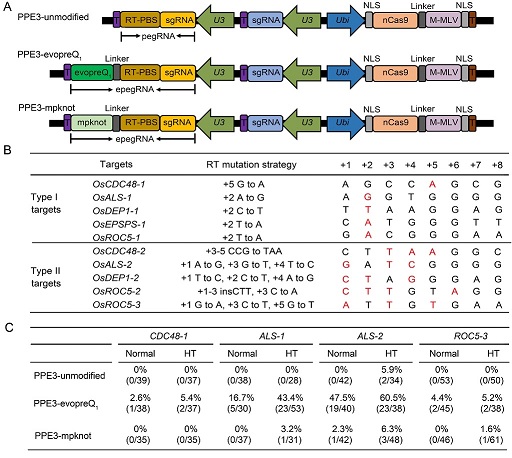






Improving the efficiency of prime editing in rice
July 19th, 2022
Recently, researchers from China National Rice Research Institute, Chinese Academy of Agricultural Sciences and Institute of Genetics and Developmental Biology, Chinese Academy of Sciences have successfully developed an efficient and widely applicable prime editing (PE) system in rice. The research was published online in SCIENCE CHINA Life Sciences.
PE system is a versatile genome editing tool that can directly write new genetic information into a specified DNA site without DSBs or donor DNA templates. However, the application of PE system in breeding is still limited due to low editing efficiency in plants. The researchers found that incorporating the structured RNA motifs (evopreQ1) to the 3′ terminus of pegRNAs (epegRNAs) could significantly improve the editing efficiencies. Meanwhile, given that the optimal working temperature of reverse transcriptase M-MLV is 42°C, the researchers found that appropriate high temperature treatment could further improve the PE efficiencies.
In conclusion, the Plant Prime Editor 3 (PPE3)-evopreQ1 system, in cooperation with appropriate high temperature treatment, was reported to have a strong synergistic effect on improving the PE efficiencies in rice. As an efficient precise editing system, the optimal system can be applied in other plants. More importantly, it provides a good foundation for the enhanced application of the PPE3 system to agricultural practice in the future.
This work was supported by the National Natural Science Foundation of China (32025028, U20A2030, 32188102), the Chinese Academy of Sciences (XDA24030504), the Central Public-interest Scientific Institution Basal Research Fund (Y2020XK17), the Agricultural Science and Technology Innovation Program (CAAS-ZDRW202001), the China National Rice Research Institute Key Research and Development Project (CNRRI-2020-01), the Hainan Yazhou Bay Seed Laboratory (B21HJ0215) and the China Agriculture Research System (CARS-01-07).
Paper link: http://engine.scichina.com/doi/10.1007/s11427-022-2147-2.

· Study Reveals How the Clock Component OsLUX Regulates Rice Heading
· Scientists Further Unravelled the Underlying Mechanism of Heading Date Control in Rice
· Improving the efficiency of prime editing in rice
· A New Infection Mechanism of Ustilaginoidea virens is Revealed
· Scientists Further Reveal the Infection Mechanism of Ustilaginoidea virens
CNRRI Today
Copyright © 2014- China National Rice Research Institute